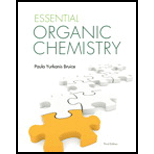
(a)
Interpretation:
The product obtained when the given alcohol reacts with
Concept introduction:
Oxidation of alcohol:
An important reagent helpful in the oxidation of alcohols is
The mechanism involves the protonation of the oxygen in the first step. Then, removal of a proton from the carbon bonded to the
(b)
Interpretation:
The product obtained when the given alcohol reacts with
Concept introduction:
Oxidation of alcohol:
An important reagent helpful in the oxidation of alcohols is
Aldehydes are formed by the oxidation of primary alcohols and ketones are formed by the oxidation of secondary alcohols. Tertiary alcohol have no reaction with
The mechanism involves the protonation of the oxygen in the first step. Then, removal of a proton from the carbon bonded to the
(c)
Interpretation:
The product obtained when the given alcohol reacts with
Concept introduction:
Oxidation of alcohol:
An important reagent helpful in the oxidation of alcohols is
Aldehydes are formed by the oxidation of primary alcohols and ketones are formed by the oxidation of secondary alcohols. Tertiary alcohol have no reaction with
The mechanism involves the protonation of the oxygen in the first step. Then, removal of a proton from the carbon bonded to the
Want to see the full answer?
Check out a sample textbook solution
Chapter 9 Solutions
Pearson eText for Essential Organic Chemistry -- Instant Access (Pearson+)
- Synthesize N-Methylcyclohexylamine from cyclohexanol using the necessary organic or inorganic reagents. Draw the structures of the compounds.arrow_forwardSynthesize N-Methylcyclohexylamine from cyclohexanol using the necessary organic or inorganic reagents. Draw the structures of the compounds.arrow_forwardIf possible, please provide the formula of the compound 3,3-dimethylbut-2-enal.arrow_forward
- Synthesize 1,4-dibromobenzene from acetanilide (N-phenylacetamide) using the necessary organic or inorganic reagents. Draw the structures of the compounds.arrow_forwardIndicate the products obtained by mixing (3-oxo-3-phenylpropyl)triphenylphosphonium bromide with sodium hydride.arrow_forwardWe mix N-ethyl-2-hexanamine with excess methyl iodide and followed by heating with aqueous Ag2O. Indicate the major products obtained.arrow_forward
- Indicate the products obtained by mixing acetophenone with iodine and NaOH.arrow_forwardIndicate the products obtained by mixing 2-Propanone and ethyllithium and performing a subsequent acid hydrolysis.arrow_forwardIndicate the products obtained if (E)-2-butenal and 3-oxo-butanenitrile are mixed with sodium ethoxide in ethanol.arrow_forward
- Question 3 (4 points), Draw a full arrow-pushing mechanism for the following reaction Please draw all structures clearly. Note that this intramolecular cyclization is analogous to the mechanism for halohydrin formation. COH Br + HBr Brarrow_forwardIndicate the products obtained if 2,2-dimethylpropanal and acetaldehyde are mixed with sodium ethoxide in ethanol.arrow_forwardIndicate the products obtained if 2,2-dimethylpropanal and acetaldehyde are reacted with sodium ethoxide in ethanol.arrow_forward
 Organic ChemistryChemistryISBN:9781305580350Author:William H. Brown, Brent L. Iverson, Eric Anslyn, Christopher S. FootePublisher:Cengage Learning
Organic ChemistryChemistryISBN:9781305580350Author:William H. Brown, Brent L. Iverson, Eric Anslyn, Christopher S. FootePublisher:Cengage Learning
